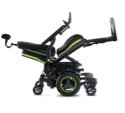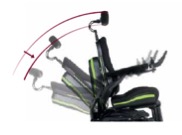Share:
Past Clinical Corner articles have addressed Dynamic Tilt and Pressure Distribution and Weight Shifting and Pressure Management. The article, Dynamic Tilt and Pressure Redistribution from October 2012, addressed clinical indications for tilt-in-space wheelchairs and the research related to dynamic tilt and pressure redistribution. The article, Weight Shifting and Pressure Management 2.0 from February 2016, addressed recommendations on duration and frequency of repositioning for pressure ulcer prevention based on clinical practice guidelines.
It is noteworthy that the terminology regarding pressure ulcers has changed since the Clinical Corner article was written last February. In April 2016, the National Pressure Ulcer Advisory Panel (NPUAP) announced the change in terminology from "pressure ulcer" to "pressure injury" as pressure injury more accurately reflects all stages of injured skin, including intact skin and open ulcers.1
This month, let's continue our look at the evidence relating to tilt, in addition to recline and elevating leg supports.
As per the Rehabilitation and Assistive Technology Society of North America (RESNA) Position on the Application of Tilt, Recline and Elevating Legrests for Wheelchairs: 2015 Current State of the Literature, the positioning features of tilt, recline and elevating legrests "enable certain individuals to:
- Realign posture and enhance function
- Enhance visual orientation, speech, alertness and arousal
- Improve physiological processes such as orthostatic hypotension, respiration, and bowel and bladder function
- Improve transfer biomechanics
- Regulate spasticity
- Accommodate and prevent contractures and orthopedic deformities
- Manage edema
- Redistribute and relieve pressure
- Increase seating tolerance and comfort
- Independently change position to allow dynamic movement."2 (p. 3)
This month, let's focus on how tilt, recline and elevating legrests work together to bring about desired results with respect to managing edema and redistributing and relieving pressure. For example, for lower extremity edema, we know that the legs must be above the level of the heart by 30 cm, achieved through a combination of tilt and elevating legrests. Elevating legrests alone cannot achieve this effect. The 2015 RESNA position paper cites research that found that a combination of elevating legrests, tilting more than 30 degrees, and using full recline improves blood flow.2 It was noted that the research was conducted on individuals without disabilities, so further research is needed with individuals with disabilities. The picture below illustrates positioning to have the legs above the level of the heart through the application of tilt and elevating leg supports:

With respect to redistributing and relieving pressure, the 2015 RESNA position paper summarized research findings and stated:
- "Tilt and recline affect pressure and perfusion at the skin and muscle tissue at the ischial tuberosities, and to a minimum extent, at the sacrum.
- Tilt, when used alone, must be greater than about 25° to achieve pressure relief and/or tissue perfusion at the ischial tuberosities.
- Recline, when used alone, can increase shear but may provide reduction in pressure at the ischial tuberosities at angles greater than 90-100°.
- The greatest reductions in pressure are seen when tilt and recline are used together, either at tilt of 35° with recline 100° or tilt of 15-25° with recline of 120°.
- Greater angles of tilt and recline generally provide better pressure relief.
- 3 minutes duration of 35° tilt with recline of 120° is more effective than 1 minute.
- Lateral weight shifting may sufficiently offload the ischial tuberosities on one side, but also simultaneously increase pressure on the other."2 (p. 8-9).
The pictures below illustrate pressure relief positions (fully reclined on the left and 35° tilt with 120° of recline with the leg supports at 145°, on the right):
As indicated above, recline can increase shear; however, anti-shear mechanisms are available in power wheelchairs to reduce shear forces. Without an anti-shear mechanism, the pivot point of the individual's body does not align with the pivot point of the recline in a back support, causing shearing forces along the trunk as the position of the trunk shifts in the back support with the movement of recline. In addition, without an anti-shear mechanism the head may be positioned well on the head support while the wheelchair is in an upright position, but the head support would be too high relative to the head in a more reclined position. With an anti-shear mechanism, the movement of the back support is adjusted as the wheelchair goes into recline to allow the individual's trunk and head remain optimally positioned on the back and head supports in all degrees of recline, minimizing shearing forces. The picture below represents the effect of an anti-shearing mechanism.

This month, we have looked at the clinical benefits of tilt, recline and elevating leg supports, and the inclusion of anti-shear mechanisms for power recline. Research has shown which angles of tilt and/or recline are required to achieve pressure relief and that greater angles of tilt and recline generally will offer greater pressure relief. A combination of tilt, recline and elevating leg supports to position the legs above the level of the heart will assist with edema management.
References
- National Pressure Ulcer Advisory Panel. (April 2016). National Pressure Ulcer Advisory Panel (NPUAP) announces a change in terminology from pressure ulcer to pressure injury and updates the stages of pressure injury. Retrieved from http://www.npuap.org/national-pressure-ulcer-advisory-panel-npuap-announces-a-change-in-terminology-from-pressure-ulcer-to-pressure-injury-and-updates-the-stages-of-pressure-injury/
- Dicianno, B.E., Lieberman, J., Schmeler, M.R., Schuler P. Souza, A.E., Cooper, R., Lange, M., Liu, H., & Jan, Y.K. (2015). RESNA position on the application of tilt, recline, and elevating legrests for wheelchairs literature update. Retrieved from https://www.resna.org/